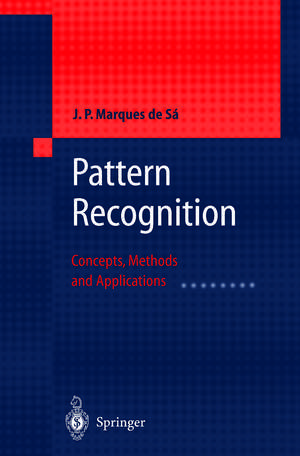Pattern Recognition: Concepts, Methods and Applications
Autor J.P. Marques de Sáen Limba Engleză Paperback – 5 dec 2012
Preț: 334.71 lei
Preț vechi: 418.38 lei
-20% Nou
Puncte Express: 502
Preț estimativ în valută:
64.04€ • 66.87$ • 52.89£
64.04€ • 66.87$ • 52.89£
Carte tipărită la comandă
Livrare economică 15-29 aprilie
Preluare comenzi: 021 569.72.76
Specificații
ISBN-13: 9783642626777
ISBN-10: 3642626777
Pagini: 344
Ilustrații: XIX, 318 p. 198 illus., 3 illus. in color.
Dimensiuni: 155 x 235 x 18 mm
Greutate: 0.48 kg
Ediția:Softcover reprint of the original 1st ed. 2001
Editura: Springer Berlin, Heidelberg
Colecția Springer
Locul publicării:Berlin, Heidelberg, Germany
ISBN-10: 3642626777
Pagini: 344
Ilustrații: XIX, 318 p. 198 illus., 3 illus. in color.
Dimensiuni: 155 x 235 x 18 mm
Greutate: 0.48 kg
Ediția:Softcover reprint of the original 1st ed. 2001
Editura: Springer Berlin, Heidelberg
Colecția Springer
Locul publicării:Berlin, Heidelberg, Germany
Public țintă
GraduateCuprins
1 Basic Notions.- 1.1 Object Recognition.- 1.2 Pattern Similarity and PR Tasks.- 1.3 Classes, Patterns and Features.- 1.4 PR Approaches.- 1.5 PR Project.- 2 Pattern Discrimination.- 2.1 Decision Regions and Functions.- 2.2 Feature Space Metrics.- 2.3 The Covariance Matrix.- 2.4 Principal Components.- 2.5 Feature Assessment.- 2.6 The Dimensionality Ratio Problem.- Exercises.- 3 Data Clustering.- 3.1 Unsupervised Classification.- 3.2 The Standardization Issue.- 3.3 Tree Clustering.- 3.4 Dimensional Reduction.- 3.5 K-Means Clustering.- 3.6 Cluster Validation.- Exercises.- 4 Statistical Classification.- 4.1 Linear Discriminants.- 4.2 Bayesian Classification.- 4.3 Model-Free Techniques.- 4.4 Feature Selection.- 4.5 Classifier Evaluation.- 4.6 Tree Classifiers.- 4.7 Statistical Classifiers in Data Mining.- Exercises.- 5 Neural Networks.- 5.1 LMS Adjusted Discriminants.- 5.2 Activation Functions.- 5.3 The Perceptron Concept.- 5.4 Neural Network Types.- 5.5 Multi-Layer Perceptrons.- 5.6 Performance of Neural Networks.- 5.7 Approximation Methods in NN Training.- 5.8 Genetic Algorithms in NN Training.- 5.9 Radial Basis Functions.- 5.10 Support Vector Machines.- 5.11 Kohonen Networks.- 5.12 Hopfield Networks.- 5.13 Modular Neural Networks.- 5.14 Neural Networks in Data Mining.- Exercises.- 6 Structural Pattern Recognition.- 6.1 Pattern Primitives.- 6.2 Structural Representations.- 6.3 Syntactic Analysis.- 6.4 Structural Matching.- Exercises.- Appendix A—CD Datasets.- A.1 Breast Tissue.- A.2 Clusters.- A.3 Cork Stoppers.- A.4 Crimes.- A.5 Cardiotocographic Data.- A.6 Electrocardiograms.- A.7 Foetal Heart Rate Signals.- A.8 FHR-Apgar.- A.9 Firms.- A.10 Foetal Weight.- A.11 Food.- A.12 Fruits.- A.13 Impulses on Noise.- A.14 MLP Sets.- A.15 Norm2c2d.- A.16 Rocks.- A.17 StockExchange.- A.18 Tanks.- A.19 Weather.- Appendix B—CD Tools.- B.1 Adaptive Filtering.- B.2 Density Estimation.- B.3 Design Set Size.- B.4 Error Energy.- B.5 Genetic Neural Networks.- B.6 Hopfield network.- B.7 k-NN Bounds.- B.8 k-NN Classification.- B.9 Perceptron.- B.10 Syntactic Analysis.- Appendix C—Orthonormal Transformation.- Appendix C—Orthonormal Transformation.
Recenzii
From the reviews of the first edition:
"The book gives an overview about the wide field of pattern recognition. … The book is primarily addressed to undergraduate and graduate students of engineering and computer science courses. It gives a good introduction into the field of clustering and pattern recognition." (Hans-Peter Altenburg, Zentralblatt MATH, Vol. 1009, 2003)
"‘Patern Recognition’ presents methods and techniques that are suitable for practical application in areas including robot assisted manufacture, medical diagnostic systems, forecast of economic variables, exploration of Earth’s resources, and satellite data analysis. … This book provides comprehensive, non-specialist coverage of pattern recognition. Although primarily aimed at undergraduate and graduate engineering and computer science students, its clear and practical coverage also makes it suitable for physicians, biologists, geologists and economists." (Assembly Automation, Vol. 22 (4), 2002)
"The book gives an overview about the wide field of pattern recognition. … The book is primarily addressed to undergraduate and graduate students of engineering and computer science courses. It gives a good introduction into the field of clustering and pattern recognition." (Hans-Peter Altenburg, Zentralblatt MATH, Vol. 1009, 2003)
"‘Patern Recognition’ presents methods and techniques that are suitable for practical application in areas including robot assisted manufacture, medical diagnostic systems, forecast of economic variables, exploration of Earth’s resources, and satellite data analysis. … This book provides comprehensive, non-specialist coverage of pattern recognition. Although primarily aimed at undergraduate and graduate engineering and computer science students, its clear and practical coverage also makes it suitable for physicians, biologists, geologists and economists." (Assembly Automation, Vol. 22 (4), 2002)
Textul de pe ultima copertă
The book provides a comprehensive view of Pattern Recognition concepts and methods, illustrated with real-life applications in several areas (e.g. engineering, medicine, economy, geology). It is appropriate as a textbook of Pattern Recognition courses and also for professionals and researchers who need to apply Pattern Recognition techniques. These are explained in a unified and innovative way, with multiple examples enhancing the clarification of concepts and the application of methods. Recent results in the main Pattern Recognition areas (Statistical Classification, Neural Networks and Structural Recognition) are presented. A CD offered with the book includes datasets and software tools, making it easier for the reader to follow the taught matters in a hands-on fashion right from the start.
Caracteristici
Unifying approach describing all relevant and recent methods Real-life problems in engineering, medicine, economy, geology solved in detail Guidance how to design PR systems and use software tools in practical applications Mathematics made easy CD-ROM with solved exercises and important software tools Includes supplementary material: sn.pub/extras











